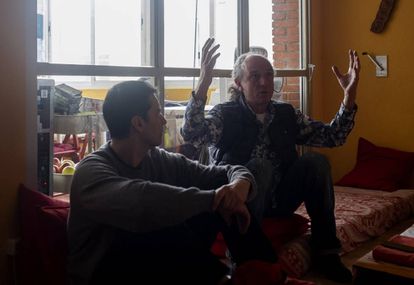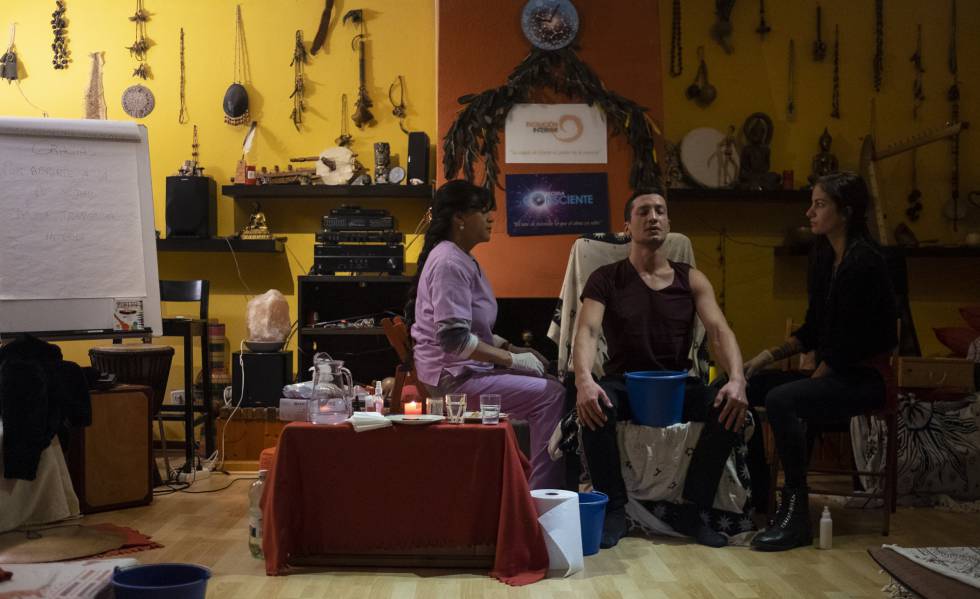
The session starts and the 12 participants gather to introduce themselves. One of them is Fernando, 55, who works in a shelter housing program in Ciudad Real and wants “to put his life in order” and improve his feelings about the state of humanity. Franka, 52, is finding it hard to get past her separation and cries as she admits to a tobacco and marijuana addiction. Then there is Taylor, a 22-year-old American who is wandering aimlessly around Europe and seeking direction.
Their stories are told in a villa in Fuente el Saz de Jarama, in the northeast of the Madrid region, where an “inner evolution retreat” run by Inner Mastery International is taking place. The retreat promises to bring about “personal transformation” with the help of ayahuasca (an entheogenic brew from the Amazon basin) as well as kambó and bufo alvarius, two types of toad venom. These substances, easily purchased online, are marketed as catalysts for “self-knowledge” that allegedly enable those who take it to overcome a specific trauma or even serious illness, despite the lack of scientific evidence. In fact, experts warn that imbibing these substances can trigger physical ailments and psychological disorders.
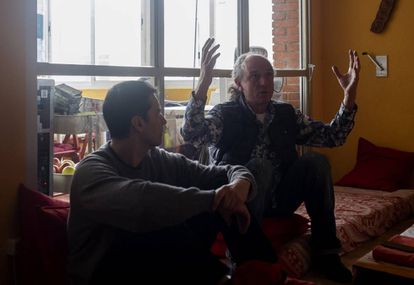
Inner Mastery International is a market leader with regard to such retreats, charging between €168 and €190 a day, depending on the length of the course. The company is run by Alberto Varela, a 59-year-old from Buenos Aires who has been overseeing a network of companies in Spain and 39 other countries on five continents for more than a decade. However, on the Business Register, he is only down as head of Evolución Interior S.L.; it is his wife, Paula Carmona, a 45-year-old Colombian, who is registered as the owner of Inner Mastery International. Meanwhile, another company called Gracias Ayahuasca S.L. is registered under the name of María José Torrabadella González who deals with the legal side of Varela’s business.
All these companies have their headquarters in Fuente el Saz de Jarama, or more precisely in the villa where Taylor, Franka and Fernando have gathered for the weekend. “The amount we invoice is not relevant,” says Varela, who is only prepared to say that €500,000 a year goes on advertising. In an article in El Confidencial some years ago, however, he stated that his business had an annual turnover of €2 million. “Our house is in order and we have a team of lawyers in the event of lawsuits. In addition, we have 150 workers registered with the Social Security system,” he says with regard to the army of self-employed workers who swarm around the villa managing the clientele, promoting courses and acting as monitors when it is time to take the hallucinogenic substances.
Legal status
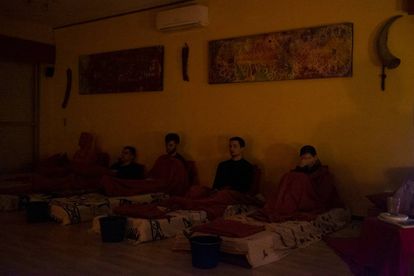
Varela makes it clear that he is neither a psychologist nor a doctor, while hailing the properties of ayahuasca. This is a man who spent 14 months in jail between 2008 and 2011 for bringing the substance into Spain, although he was subsequently acquitted. He insists that everything they handle is legal, but that they take extreme precautions because the authorities are just waiting for them to make a wrong move.
In Spain, ayahuasca is not considered illegal. There have been no convictions for public health crimes linked to its sale or use, despite the fact it has featured in 26 court cases since 2007, according to Spain’s judiciary watchdog, the CGPJ. In all 26 cases, the plant is described as “stimulating” and “psychotropic,” although both the Foundation for Help against Drug Addiction (FAD) and Reguera Abogados, a law firm specialized in drug trafficking, say there are very few cases of trafficking ayahuasca, kambó or bufo alvarius, or even of dependence on these substances.
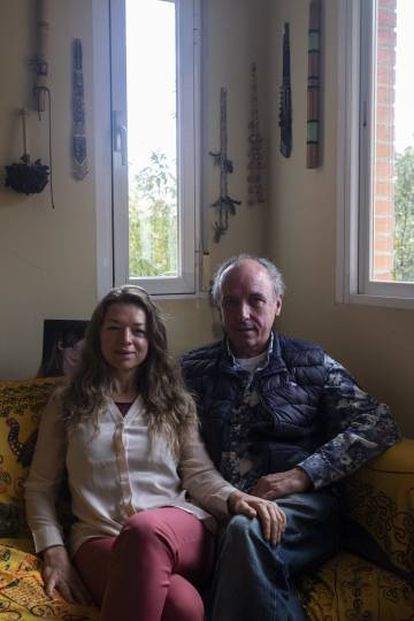
Meanwhile, Gonzalo Haro Cortés, director of the Spanish Society of Dual Pathology and professor at the Cardenal Herrera-CEU University of Castellón, points out that neither are considered drugs by the World Health Organization’s 1971 Vienna Convention. On account of this, and the fact they are not widely consumed, they are not illegal. In the case of ayahuasca and bufo alvarius, the controversial substance is dimethyltryptamine (or DMT), which causes hallucinations just like other entheogens such as LSD, peyote and certain types of mushroom.
Inside the villa, participants are introduced to the “medical and psychological team” before the substance-taking session begins. One of the team members is Sergio Sanz, who guides the sessions at which participants express their troubles and worries. “Our aim is to reach a deeper point of surrender,” he explains in between strumming a guitar and hugging people. “Ayahuasca is just a prelude. Many people bring a culture of punishment with them, and the idea is to be innocent. Here you realize that the best thing you can do for humanity is not to harm yourself.” After finishing his studies in Barcelona, this 27-year-old joined the company and has been working with it for the past five years.
The participants are preparing to take the ayahuasca and are moved to the living room, a large space with candles, Buddha figures, strategically placed loudspeakers and 12 mattresses on the floor.
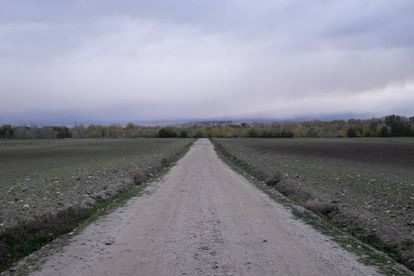
When a glass jar filled with a brownish concoction is brought out, Pancho Vázquez, an old hand at this, takes the opportunity to ask who will be trying the kambó the following day at an added cost of €125. Four people sign up and then the presentations begin, which is when Fernando, Franka and Taylor explain why they are here. After all 12 participants have introduced themselves – with English translations for a group from Bulgaria and Moldova – the silence resumes.
The shot
While one of the workers plays the djembe drum, another staff member, Fernando Álvarez, 25, appears on the scene. He explains the best way of taking ayahuasca as he passes round the “medicine.” His advice is to lie down and, in the event of nausea, to use the buckets that are placed by each mattress. “Everything that comes out – sweat, vomit, poop – is what we needed to get rid of,” he says. “The vomit is an energy-charged vomit. It symbolizes something very special, which is why I suggest you look at it it before cleaning the bucket. I usually feel like giving it thanks. By cleaning the bucket, you are cleansing yourself.”
The scene is set with incense and soft music. It is shortly before midnight and the session will last about five hours. Apart from those who are busy vomiting and visiting the bathroom, the participants remain horizontal, apparently in a stupor. The monitors, meanwhile, take turns putting on YouTube videos, giving out more doses of ayahuasca and also rapé, a snuff which is inhaled through a small pipe.
Yawns are heard while Alvarez chants mantras such as: “I open myself to the crazy plan of this mysterious love,” and “Enjoying every hug, enjoying every kiss, enjoying every moment.” There is instrumental music and hits by Pablo Alborán and Ludovico Einaudi. When the session ends, participants can either stay on their mattress or go to bed. Almost everyone leaves. Before they do, Karim Pascua, 48, asks what time breakfast is. “I had a very raw moment,” he says, smoking a cigarette. “But, apart from diarrhea, nothing.”
Psychotic episodes
Guillermo Fouce, president of Psychology Without Borders, considers substances such as ayahuasca and kambó to be harmful. “They are often used by sects and sold as something that triggers a quest, but in reality, like any other drug, they cause changes in the body and create addiction, besides which they can trigger psychotic episodes,” he says.
According to Haro Cortés, “There is now a type of consumer called a psychonaut – a traveler or researcher of drugs.” Cortés adds that these substances are linked to one of the three happiness hormones – dopamine, norepinephrine or serotonin – as well as to introspection and visions. “It’s like a parachute jump,” he says. “Either nothing can happen or you can hit a rock.”
English version by Heather Galloway.
Get real time update about this post categories directly on your device, subscribe now.






